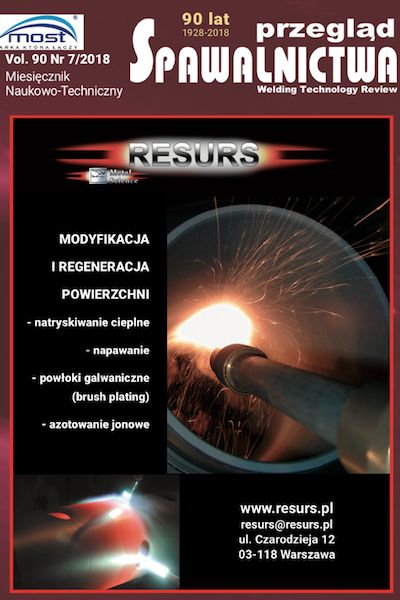Logarithmic damping decrement in the diagnosis of welded joints
Main Article Content
Abstract
The article presents a vibrodiagnostic, non-destructive assessment method of welded joints where damping decrement change was used. SHM importance in sea constructions was discussed. Responses received while inspection (registered by acceleration sensors) provide diagnostics that require mathematic processing to extract the important characteristics of examined welded joints that were recorded and to assess quality of the joint. A method based on calculation of the damping decrement which changes over time as the response changes was presented in the paper. Due to complicated course of the responses, the damping decrement was calculated using approximation of the responses by many mathematical functions. The result of the analysis shows that the damping decrement change over time allows assessing quality of the joint when used in welded plates. Elements vital to carrying out examination of welded plates using vibrodiagnostic method were discussed, an calculation algorithm and example results of applicating this method at welded plates with several different detects were presented.
Downloads
Article Details
Creative Commons CC BY 4.0 https://creativecommons.org/licenses/by/4.0/
Welding Technology Review (WTR) articles are published open access under a CC BY licence (Creative Commons Attribution 4.0 International licence). The CC BY licence is the most open licence available and considered the industry 'gold standard' for open access; it is also preferred by many funders. This licence allows readers to copy and redistribute the material in any medium or format, and to alter, transform, or build upon the material, including for commercial use, providing the original author is credited.
References
Bień J.: Uszkodzenia i diagnostyka obiektów mostowych, WKŁ, Warszawa 2010.
Czurchryj J., Papkala H., Winiowski A.: Niezgodności w złączach spajanych, Instytut Spawalnictwa Gliwice 2005.
Czuchryj J.: Badanie złączy spawanych wg norm europejskich. Systematyka i przyczyny postania wad w złączach spawanych, Biuro Gamma Warszawa 2003.
Krajewski A., Hudycz M.: Zapewnienie jakości i kontrola złączy spajanych, Oficyna Wydawnicza Politechniki Warszawskiej, Warszawa 2015.
Lewicka-Romicka A.: Badania nieniszczące. Podstawy defektoskopii, Wydawnictwo Naukowo-Techniczne Warszawa 2001.
Murawski L., Ostachowicz W., Opoka S., Mieloszyk M., Majewska K: Practical application of monitoring system based on optical sensors for marine constructions. Key Engineering Materials, Vol. 518, 2012.
Opoka S., Murawski L., Wandowski T., Malinowski P., Ostachowicz W.: Static Strain Level Change Together with Detection of Transient Signal as Damage Indicator for Truss and Fame Structures. Strain, Vol. 49 Issue 4, August 2013.
Szeleziński A., Gesella G., Murawski L.: Przegląd metod diagnostyki i monitoringu połączeń spawanych w konstrukcjach transportu morskiego, Logistyka 3/2015.
Szeleziński A., Murawski L., Muc A., Gesella G.: Badania wstępne możliwości diagnostyki połączeń spawanych przy pomocy analizy charakterystyk dynamicznych, Zeszyty Naukowe Akademii Morskiej w Gdyni nr 96/2016.
Szeleziński A., Murawski L., Muc A.: Analysis of ability to detect defects in welding structures with usage of dynamic characteristics spectrums. Journal of KONES Powertrain and Transport, Vol. 23, No 2, European Science Society of Powertrain and Transport Publication, Warsaw 2016.
